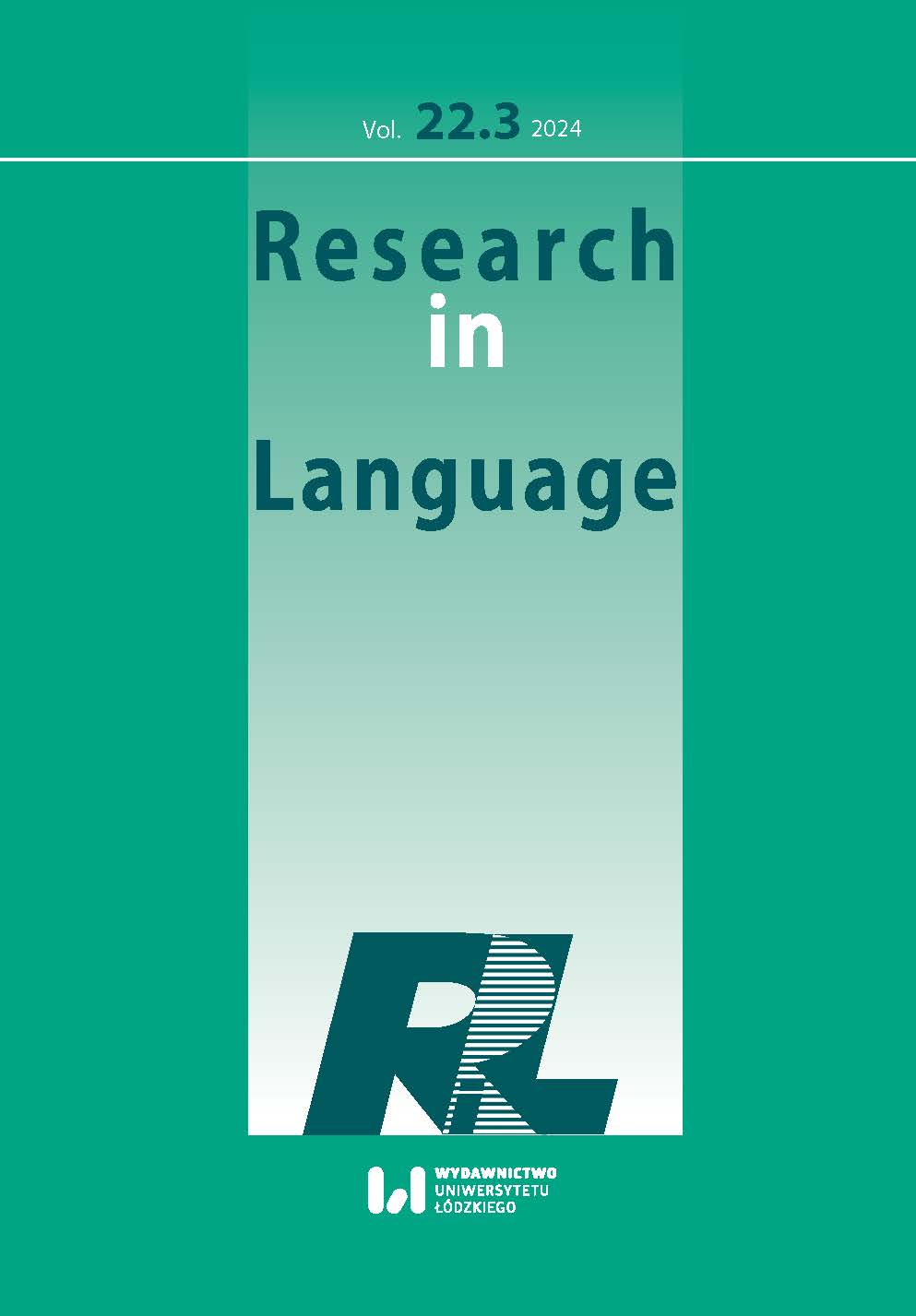Creativity in Meaning Construction and Translation – A Cognitive Perspective on the Humurous Language Used by Big Friendly Giant in Roald Dahl’s the BFG in its English, Polish and Portuguese Versions
DOI:
https://doi.org/10.18778/1731-7533.22.3.04Keywords:
conceptual blending, mental maps, creative cognition, humour, children’s literatureAbstract
The paper explains how our mind creates a meaning in a wordplay. The model of mental maps (Author, 2020) based on the theory of conceptual blending (Fauconnier,1997, Fauconnier & Turner, 2002) and the geneplore model based on the theory of creative cognition (Finke, et al, 1992) presented in the paper describe the operations in the mind related to generating, exploring and transforming ideas and/or linguistic and non-linguistic units that result in the emergence of a new meaning embedded in the wordplay. To illustrate the cognitive processes in meaning construction, the paper refers to the humorous language of Big Friendly Giant in Roald Dahl’s The BFG in its original English version as well as its translations into Polish and Portuguese.
References
Barsalou, L. W. 1987. The instability of graded structure. Implications for the nature of concepts In U. Neisser (ed.) Concepts and conceptual development. Ecological and intellectual factos in categorization (p. 101-140) Cambridge University Press.
Google Scholar
Baughman, W. A. & Mmford, M. D. 1995. Process-analytic models of creative capacities: operations influencing the combination and reorganization processes Creativity Research Journal 8, 37-62. https://doi.org/10.1207/s15326934crj0801_4
Google Scholar
DOI: https://doi.org/10.1207/s15326934crj0801_4
Coulson, S. 2001. Semantic Leaps: Frame-Shifting and Conceptual Blending in Meaning Construction. Cambridge University Press. https://doi.org/10.1017/CBO9780511551352
Google Scholar
DOI: https://doi.org/10.1017/CBO9780511551352
Coulson, S., Urbach, T., & Kutas, M. 2006. Looking back: Joke Comprehension and the Space Structuring Model. Humor – International Journal of Humor Research, 19, 229-250. https://doi.org/10.1515/HUMOR.2006.013
Google Scholar
DOI: https://doi.org/10.1515/HUMOR.2006.013
Dahl, Roald. 1982/2007. The BFG, London: Puffin Books.
Google Scholar
Dahl, Roald. 1982/2003 .BFO trans. Jerzy Łoziński, Poznań: Zysk i S-KA Wydawnictwo.
Google Scholar
Dahl, Roald. 1982/2015. GGG O Grande Gigante Gentil, trad. Susana Ferreira e Bárbara Soares, Alfragide: Oficina do Livro – Sociedade Editorial, Lda.
Google Scholar
Dahl, Roald. 1982/2016. O Bom Gigante Amigo. trans. Angela Mariani. Edição comemorativa do centanário de Roald Dahl (1916-1990), São Paulo: Editora34.
Google Scholar
Evans, V., Green, M., 2006. Cognitive Linguistics. An Introduction, Edinburgh: Edinburgh University Press.
Google Scholar
Fauconnier, G. 1997. Mappings in Thought and Language, Cambridge: Cambridge University Press. https://doi.org/10.1017/CBO9781139174220
Google Scholar
DOI: https://doi.org/10.1017/CBO9781139174220
Fauconnier, G., Turner, M. 2002. The Way We Think. Conceptual Blending and the Mind’s Hidden Complexities, New York: Basic Books.
Google Scholar
Fauconnier, G., Turner, M. 2003. Conceptual Blending, Form and Meaning Recherches en communication, nº 19.
Google Scholar
DOI: https://doi.org/10.14428/rec.v19i19.48413
Finke, R. A. 1990. Creative imagery: Discoveries and inventions in visualization. Hillsdale, NJ: Erlbaum.
Google Scholar
Finke, R. A. & Slayton, K. 1988. Explorations of creative visual synthesis in mental imagery. Memory and Cognition, 16, 252-257. https://doi.org/10.3758/BF03197758
Google Scholar
DOI: https://doi.org/10.3758/BF03197758
Finke, R. A., Ward, T. B., Smith, S. M. 1992 /1996. Creative Cognition. Theory Research, and Applications, Cambridge, Massachusetts/ London: The MIT Press. https://doi.org/10.7551/mitpress/7722.001.0001
Google Scholar
DOI: https://doi.org/10.7551/mitpress/7722.001.0001
Gentner D. 1989 The mechanisms of analogical learning In Similarity and Analogical Reasoning (p. 199-241) Cambridge University Press. https://doi.org/10.1017/CBO9780511529863.011
Google Scholar
DOI: https://doi.org/10.1017/CBO9780511529863.011
Hampton, J. A. 1997. Emergent attributes in combined concepts In T. B. Ward, S. M. Smith & J. Vaid (eds.) Creative Thought. An Investigation of Conceptual Structures and Processes (p. 83-110) Washington, D. C.: American Psychological Association. https://doi.org/10.1037/10227-004
Google Scholar
DOI: https://doi.org/10.1037/10227-004
Holyoak, K. J. & Thagard, P. R. 1995. Mental Leaps. Cambridge, MA: the MIT Press. https://doi.org/10.7551/mitpress/4549.001.0001
Google Scholar
DOI: https://doi.org/10.7551/mitpress/4549.001.0001
Klos, Sylwia. 2020. Humour and Translation in Children’s Literature. A Cognitive Approach, Katowice: Wydawnictwo Uniwersytetu Śląskiego.
Google Scholar
Mednick, S. A. 1962 The associative basis of the creative process. Psychological Review 69, 220-232. https://doi.org/10.1037/h0048850
Google Scholar
DOI: https://doi.org/10.1037/h0048850
Murphy, G. L. 1988. Comprehending complex concepts. Cognitive Science 12, 529-562. https://doi.org/10.1016/0364-0213(88)90012-2
Google Scholar
DOI: https://doi.org/10.1016/0364-0213(88)90012-2
Novick, L. 1988. Analogical transfer, problem similarity, and expertise. Journal of Experimental Psychology: Learning, Memory, and Cognition 14, p. 510-520. https://doi.org/10.1037//0278-7393.14.3.510
Google Scholar
DOI: https://doi.org/10.1037//0278-7393.14.3.510
Ortony, A. 1990. Beyond literal similarity. Psychological Review 86, 161-180. https://doi.org/10.1037//0033-295X.86.3.161
Google Scholar
DOI: https://doi.org/10.1037//0033-295X.86.3.161
Perkins, D. N. 1981. The Mind’s Best Work, Cambridge, MA: Harvard University Press. https://doi.org/10.4159/9780674042032
Google Scholar
DOI: https://doi.org/10.4159/9780674042032
Shepard, R. N. 1978. Externalization of mental images and the act of creation In B. S. Randhawa and W. E. Coffman (eds.) Visual Learning, Thinking, and Communication (p. 133-189) New York: Academic
Google Scholar
Shepard, R. N. & Feng, C. 1972. A chronometric study of mental paper folding. Cognitive Psychology 3, 228-243. https://doi.org/10.1016/0010-0285(72)90005-9
Google Scholar
DOI: https://doi.org/10.1016/0010-0285(72)90005-9
Smith, S. M. 1979. Remembering in and out of context. Journal of Experimental Psychology: Human Learning and Memory, 5, 460-471. https://doi.org/10.1037//0278-7393.5.5.460
Google Scholar
DOI: https://doi.org/10.1037//0278-7393.5.5.460
Thomson, A. L., Klatzky, R. L, 1978. Studies of visual synthesis. Integration of fragments into forms. Journal of Experimental Psychology: Human Perception and Performance, 4, 244-263. https://doi.org/10.1037//0096-1523.4.2.244
Google Scholar
DOI: https://doi.org/10.1037//0096-1523.4.2.244
Ward, T. B. 1994. Structured imagination: the role of conceptual structure in exemplar generation. Cognitive Psychology, 27, 244-263. https://doi.org/10.1006/cogp.1994.1010
Google Scholar
DOI: https://doi.org/10.1006/cogp.1994.1010
Ward, T. B. 1995. What’s old about new ideas? In S. M. Smith, T. B. Ward & R. A. Finke (eds.) The creative cognition approach (p. 157-178), Cambridge, MA: MIT Press.
Google Scholar
Downloads
Published
How to Cite
Issue
Section
License

This work is licensed under a Creative Commons Attribution-NonCommercial-NoDerivatives 4.0 International License.










